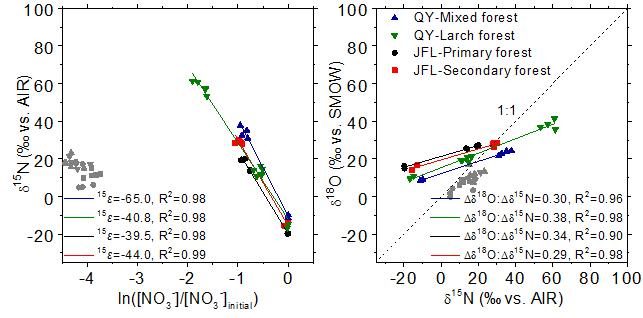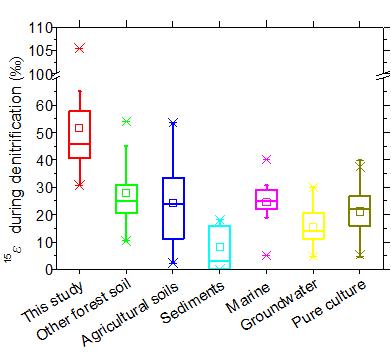Denitrification has been considered a major process removing available N from ecosystems and also a major mechanism leading N limitation of ecosystems. However, the denitrification rates are difficult to quantify due to the lack of direct determination method of denitrification rate from the ecosystem scale.
In recent years, the 15N natural abundance has been used to determine the denitrification rate from the ecosystem scale. But, using 15N natural abundance to quantify denitrification rates relies heavily on the N isotope fractionation during denitrification. And previous studies found that the N isotope effect (15ε) varies greatly with environmental and experimental conditions.
Although numerous studies of the N isotope effect focused on pure cultures of heterotrophic denitrifying bacteria, groundwater, sediments and agricultural soils, limited studies existed in forest soils.
Thus, to advance the understanding of isotopic fractionation during denitrification in forest soils and reduce the uncertainty in denitrification estimates, it is critical to investigate the N and O isotope fractionation during denitrification in forest soils.
Prof. FANG Yunting's lab from the Institute of Applied Ecology of the Chinese Academy of Sciences, therefore, selected two temperate forests in Qingyuan and two from tropical forests in Hainan to investigate the N and O isotope fractionation of N and O of NO3- during denitrification by native soil microbial communities as well as the relationship between N and O isotopes (△δ18O:△δ15N).
They found that the N isotope effects (15ε) ranged from 31‰ to 65‰ (Figure 1), much higher than reported in the literature for heterotrophic denitrification (typically ranging from 5‰ to 30‰) and in other environmental settings (e.g., groundwater, marine sediments and agricultural soils)(Figure 2).
Unlike the large Nisotope effects, the Oisotope effects (18ε, 11‰-39‰) were comparable to other studies.
Furthermore, the ratios of △δ18O:△δ15N ranged from 0.28 to 0.60 (Figure 1), which were lower than the canonical ratios of 0.5 to 1 for denitrification reported in other terrestrial and freshwater ecosystems.
Their results suggested that the N isotope effects of denitrification in soils may vary greatly among regions and soil types.
They further applied the high N isotope effect to estimate the denitrification rates and found that the contribution of denitrification to total N losses may have been overestimated for terrestrial ecosystems.
The results were published entitled "High nitrogen isotope fractionation of nitrate during denitrification in four forest soils and its implications for denitrification rate estimates" in Science of the Total Environment.
The work was supported by National key R & D projects in China, CAS Special pilot Project and NNSFC.

Fig. 1 Nitrogen isotope effect (15ε) and the ratio of O and N isotopic fractionation (△δ18O:△δ15N) during denitrification (Image by WANG Ang).

Fig. 2 Variations in15ε of denitrification under different environmental and experimental (Image by WANG Ang).
Email: yueqian@iae.ac.cn
Publication Name: WANG Ang et al.